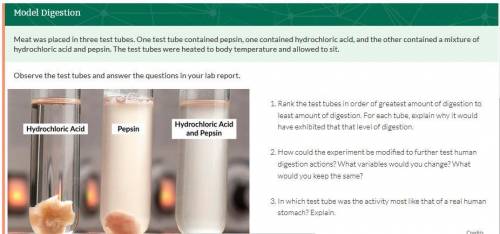100 Points!
(Score for Question 1: ___ of 2 points)
1. Using the image provided in...

Biology, 28.03.2020 22:40 emmadivaburnsox7ae9
100 Points!
(Score for Question 1: ___ of 2 points)
1. Using the image provided in the lab, rank the test tubes in order of greatest amount of digestion to least amount of digestion. For each tube, explain why it would have exhibited that level of digestion.
Type your answer here.
(Score for Question 2: ___ of 4 points)
2. How could the experiment be modified to further test human digestion actions? What variables would you change? What would you keep the same?
Type your answer here.
(Score for Question 3: ___ of 2 points)
3. In which test tube was the activity most like that of a real human stomach? Explain.
Procedure Part 4 (10 points)
Using digestive compounds like those in the stomach and saliva, you can simulate human digestion in a lab.
First, you will look at the results of an experiment that tested conditions to model digestion in the stomach. Then, you will conduct an experiment to see how vinegar affects digestion of starch in saliva.
Materials
• Lab Report: Human Digestion Actions with Household Items
• Laboratory Guidelines
• Saltine crackers
• Iodine
• Vinegar
• Bowls or cups
• Water
• Tablespoon
LEARN
Safety
Review the safety practices and guidelines found in Safety in the Lab. Review the Laboratory Guidelines before conducting the lab. Do not eat or drink any of the substances after you have used them in the lab. Iodine can stain substances, including skin. Wear gloves to protect your skin. Iodine is toxic by ingestion and inhalation, and can cause burns on contact. Do not breathe vapors or mist. Keep all containers out of the reach of small children or pets. Notify everyone in the home that you are conducting an experiment, and tell them not to touch any containers. Properly dispose of all materials that will not be reused. Carefully clean all lab materials that you will use again.
Background:
Digestion takes place in saliva. Amylase is an enzyme in saliva that breaks down starch into sugars. If you try chewing a piece of rice or small piece of a saltine cracker, foods that are high in starch and low in sugar, you may notice they start to taste sweet over time. Starch turns a dark blue-black when in the presence of iodine. You can test how much starch has been digested by the amylase in saliva by comparing the color of iodine placed in several samples.
1. Label three cups as follows: water, water and saliva, vinegar and saliva.
2. Pour one tablespoon of water into the two cups labeled with water.
3. Pour one tablespoon of vinegar into the cup labeled with vinegar.
4. Spit into the containers labeled with saliva. Try to get approximately the same amount of saliva into each container.
5. Break off three small pieces of saltine cracker. Try to get the pieces close to the same size. One small corner of the cracker (approximately 4 mm by 4 mm) will work for each sample.
6. Break up each piece into small pieces to simulate chewing. Do not actually chew the cracker sample to be tested. Place the samples into the labeled cups.
7. Allow the mixtures to sit for one hour.
8. Add several drops of iodine to each cup.
9. Observe the results and record your observations.
Part 4 Results
(Score for Question 4: ___ of 10 points)
Describe your experimental results: (3 points)
Experiment Observations
water
Water and saliva
Vinegar and saliva
How did the vinegar affect the digestion of starch? (3 point)
Explain using the results of your experiment. (4 points)


Answers: 1


Other questions on the subject: Biology

Biology, 22.06.2019 00:00, mya032
Mouse liver cells were homogenized and the homogenate subjected to equilibrium density-gradient centrifugation with sucrose gradients. fractions obtained from these gradients were assayed for marker molecules (i. e., molecules that are limited to specific organelles). the results of these assays are shown in the figure. the marker molecules have the following functions: cytochrome oxidase is an enzyme involved in the process by which atp is formed in the complete aerobic degradation of glucose or fatty acids; ribosomal rna forms part of the protein-synthesizing ribosomes; catalase catalyzes decomposition of hydrogen peroxide; acid phosphatase hydrolysis monophosphoric esters at acid ph; cytidylyltransferase is involved in phospholipid biosynthesis; and amino acid permease aids in transport of amino acids across membranes. a) name the marker molecule and give the number of the fraction that is most enriched for each of the following cell components: lysosomes; peroxisomes; mitochondria; plasma membrane; rough endoplasmic reticulum; smooth endoplasmic reticulum.
Answers: 3

Biology, 22.06.2019 09:00, faizanaj1192
When a gasoline engine burns gasoline, what type of chemical reaction is occurring?
Answers: 1
You know the right answer?
Questions in other subjects:



Biology, 15.11.2019 00:31

Mathematics, 15.11.2019 00:31






Biology, 15.11.2019 00:31



